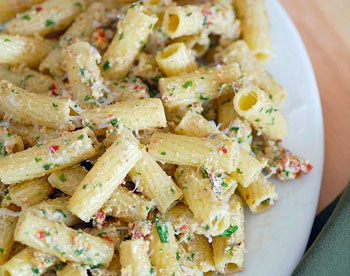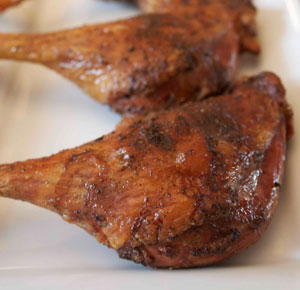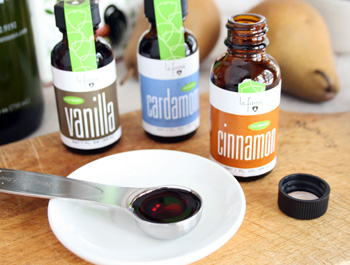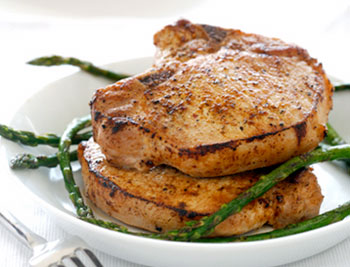 There once was a time when basil reigned supreme. A time when basil was ubiquitous in Italian dishes. A time when pesto always meant basil.
There once was a time when basil reigned supreme. A time when basil was ubiquitous in Italian dishes. A time when pesto always meant basil.
Not anymore.
Pesto is a Ligurian sauce made from mashed basil, garlic, parmesan, olive oil, and pine nuts. Though it has been enjoyed by Italians for centuries, it's a newborn to American cuisine. Sunset magazine was instrumental in introducing this sauce to Americans, when in 1946, it published a pesto recipe by Tuscan native, Angelo Pellegrini. It wasn't until the 1980's and early '90s that pesto became widely popular with chefs and home cooks, who could easily buy fresh basil at the market.
Maybe it was boredom with basil. Maybe it was creative genius by some chefs. Whatever it was, by the mid to late '90s new "pestos" made with herbs such as mint, parsley, and sage were popping up in restaurants and in cooking magazines. Now "pesto" would have to be qualified: mint pesto or sage pesto. Some people were thrilled. Others confused. Some indignant. Pesto purists (you know who you are) will argue that "pesto," refers to the Ligurian sauce made with basil. For them, all other "pestos" are imposters.
Cooking Techniques and Kitchen Gadgets
Cooking and Gadgets
Cooking Duck
 The first time I cooked duck, I was completely freaked out. "Duck!" seemed way too exotic, too odd, too French for me to deal with. Duck had too much tradition behind it. Chicken was my safe-zone fowl.
The first time I cooked duck, I was completely freaked out. "Duck!" seemed way too exotic, too odd, too French for me to deal with. Duck had too much tradition behind it. Chicken was my safe-zone fowl.
Anyway, I took the plunge and cooked a whole duck. It turned out...ok. There's all that fat to deal with and the fact that the whole bird is dark meat. After dozens of outings, I figured out how to cook duck, and, I have to say, duck is great. Taste-wise it's midway between chicken and beef, but better than either.
To the point: cooking a whole duck is an obligation. Cooking duck legs and thighs is a lot more normal. Think "chicken" and it won't seem so special, but the end result will be.
l.c. finn's Roasted Pears Warm the Soul
 Some say it makes no difference what kind of vanilla is used in cookies, cakes, quick breads and custards. Some home bakers are sure artificial vanilla flavoring works just fine for giving the best flavor to their baked goods. Others would argue that you shouldn’t waste your time baking if you use artificial flavoring. Only the real deal, pure vanilla extract, will work for giving the best flavor to desserts.
Some say it makes no difference what kind of vanilla is used in cookies, cakes, quick breads and custards. Some home bakers are sure artificial vanilla flavoring works just fine for giving the best flavor to their baked goods. Others would argue that you shouldn’t waste your time baking if you use artificial flavoring. Only the real deal, pure vanilla extract, will work for giving the best flavor to desserts.
I’m a member of the pure vanilla extract club. I would never use an imposter in the custard for our family’s special banana cake, layers upon layers of homemade vanilla custard, sliced bananas and vanilla wafers covered with a thick blanket of real whipped cream. My special pound cake would have something missing if it was made with artificial vanilla. Pure vanilla extract costs a bit more than its artificial look-alike, but to me, it’s worth every penny.
Chad Gillard and Lee Zwiefelhofer favor the real deal, too. The two Twin Cities guys were discussing the absence of locally-made vanilla extract – extracts of any kind, really, as they downed some Finnegans together. They decided they’d make it themselves. In 2010 they started a company called l.c. finn’s Extracts, l. for Lee, c. for Chad and finns for those Finnegans that were downed as the business ideas developed. A few months ago, they launched their first three extracts: vanilla, cinnamon and cardamom.
Top Kitchen Toy? The Cellphone
From the New York Times
 The tech revolution has been a long time in coming to the kitchen. Our
coffee machines are so advanced that they can practically drive us to
work, but Internet-controlled toasters and Web-enabled refrigerators
became punch lines.
The tech revolution has been a long time in coming to the kitchen. Our
coffee machines are so advanced that they can practically drive us to
work, but Internet-controlled toasters and Web-enabled refrigerators
became punch lines.
One high-tech cooking tool, however, has transformed the kitchen lives of many Americans: the cellphone. It has become the kitchen tool of choice for chefs and home cooks. They use it to keep grocery lists, find recipes, photograph their handiwork, look up the names of French cheeses, set timers for steak and soft-boiled eggs, and convert European or English measurements to American ones.
“It taught me to cook, really,” said Kelli Howell, a college sophomore in Chicago, of her Nokia phone. Its photography, Internet and instant-messaging capabilities let her consult with friends, family and online sources as she got started in the kitchen. “I e-mailed about 20 pictures of a vegetable lasagna to my sister’s phone while I was making it,” she said. “And then I I.M.’ed with my mom about the topping.”
Brine Divine
 If you look in the dictionary under the word "impatient" you’ll most likely see my picture a few rows down. My disdain for playing the waiting game is a big reason why I don’t pickle, bake, brew or preserve too well, although I have aced the sauté, grill, and fry like nobody’s business. So you can imagine my dilemma when I first learned about brining meat. There were numerous knuckle biting moments when I had to accept that soaking meat for what seemed like an eternity really did yield a more flavorful, juicy bite. I may not have learned to deal with sitting around doing nothing, but I have certainly surrendered to the divine brine.
If you look in the dictionary under the word "impatient" you’ll most likely see my picture a few rows down. My disdain for playing the waiting game is a big reason why I don’t pickle, bake, brew or preserve too well, although I have aced the sauté, grill, and fry like nobody’s business. So you can imagine my dilemma when I first learned about brining meat. There were numerous knuckle biting moments when I had to accept that soaking meat for what seemed like an eternity really did yield a more flavorful, juicy bite. I may not have learned to deal with sitting around doing nothing, but I have certainly surrendered to the divine brine.
Brining is soaking poultry or pork in salted, seasoned liquid prior to cooking. It’s similar to marinating, but this process actually changes the texture of the meat. And it’s very simple. Depending on the brine and the cut of meat, the process can occur overnight or in as little as a few hours in your fridge–and the results are spectacular. The meat is juicy and flavorful, seasoned from within. And the best part happens when you grill: you’ll get that desired smoky char on the outside with a tender, moist texture on the inside. I don’t know about you, but I have a hard time achieving both when I grill if I don’t brine.
More Articles ...
Welcome to the new One for the Table ...
Our Home Page will be different each time you arrive.
We're sure you'll find something to pique your interest...


